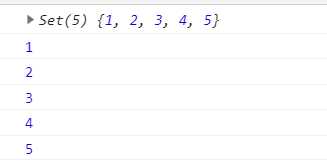标签:=== mys find 资料 使用数组 tar abc 函数 键值对存储
为了方便大家更好的了解和学习set,我在这里会将这些方法和属性进行分类整理和讲解
<!DOCTYPE html> <html> <head> <meta charset="UTF-8"> <title>数组去重</title> </head> <body> <script type="text/javascript"> const set=new Set(); //创建set数据结构 [1,1,2,3,4,5].forEach(x=>{ set.add(x); }) console.log(set); //1,2,3,4,5 for(let i of set){ console.log(i); } </script> </body> </html>

可以看到向Set添加成员时,不会添加重复的值
<!DOCTYPE html> <html> <head> <meta charset="UTF-8"> <title></title> </head> <body> <div></div> <div></div> <div></div> <div></div> <div></div> <script type="text/javascript"> // const set=new Set([1,2,3]); // console.log(...set);//1,2,3,使用扩展运算符 const set=new Set(document.querySelectorAll(‘div‘)); console.log(set.size);//5 size返回set实例的成员总数 //如上代码相当于 const item=new Set(); document.querySelectorAll(‘div‘).forEach(x=>{ item.add(x); }) console.log(item); console.log(item.size);//5 </script> </body> </html>
<!DOCTYPE html> <html> <head> <meta charset="UTF-8"> <title>向set中添加成员时,不会发生类型转换</title> </head> <body> <script type="text/javascript"> let mySet=new Set(); mySet.add(5); mySet.add(‘5‘); console.log(mySet);//5,‘5‘ let set=new Set(); let a=NaN; let b=NaN; set.add(a); set.add(b); console.log(set);//NaN </script> </body> </html>
向 Set 加入值的时候,不会发生类型转换,所以5和"5"是两个不同的值。Set 内部判断两个值是否不同,使用的算法叫做“Same-value-zero equality”,它类似于精确相等运算符(===),主要的区别是向 Set 加入值时认为NaN等于自身,而精确相等运算符认为NaN不等于自身。
<!DOCTYPE html> <html> <head> <meta charset="UTF-8"> <title>向set中添加的对象总是不想等</title> </head> <body> <script type="text/javascript"> let set=new Set(); set.add({});//向set中添加一个空对象 console.log(set.size);//1 set.add({});//向set中添加另一个空对象 console.log(set.size);//2 </script> </body> </html>
由于两个空对象不行等,所以它们被视为两个值
<!DOCTYPE html> <html> <head> <meta charset="UTF-8"> <title>set中的size属性</title> </head> <body> <script type="text/javascript"> const set=new Set(); //向set中添加成员 set.add(1); set.add(2); set.add(3); //链式方法 set.add(4).add(5).add(6); console.log(set.size);//6 </script> </body> </html>
<!DOCTYPE html> <html> <head> <meta charset="UTF-8"> <title>set中的操作方法add()、delete()、has()、clear()</title> </head> <body> <script type="text/javascript"> const set=new Set(); //向set中添加成员 set.add(1); set.add(2); set.add(3); //链式方法 set.add(4).add(5).add(6); console.log(set.size);//6 console.log(set.has(1));//true set.delete(1); console.log(set.has(1));//false set.clear();//清空全部set成员 console.log(set.size);//0 </script> </body> </html>
注意:set的遍历顺序就是插入顺序,由于set没有键名,只有键值(或者说键名和键值是同一个值),所以keys()和values()方法的行为完全一致
<!DOCTYPE html> <html> <head> <meta charset="UTF-8"> <title>set中的遍历方法keys(),values(),entries(),forEach()</title> </head> <body> <script type="text/javascript"> let set=new Set([‘red‘,‘blue‘,‘green‘]); //遍历全部的key for(let key of set.keys()){ console.log(key);//red,blue,green } //遍历全部的value for(let value of set.values()){ console.log(value);//red,blue,green } //遍历全部的key和value for(let item of set.entries()){ console.log(item);//[‘red‘,‘red‘],[‘blue‘,‘blue‘],[‘green‘,‘green‘] } set.forEach((key,value)=>{ console.log(key+‘:‘+value); }) </script> </body> </html>
es6中的map很大程度上和set相似,但是map是以键值对的形式存储数据的
<!DOCTYPE html> <html> <head> <meta charset="UTF-8"> <title>map中的size属性</title> </head> <body> <script type="text/javascript"> const map=new Map(); map.set(‘foo‘,true); map.set(‘bar‘,false); console.log(map.size);//2 </script> </body> </html>
<!DOCTYPE html> <html> <head> <meta charset="UTF-8"> <title>map中的set()方法</title> </head> <body> <script type="text/javascript"> const map=new Map(); map.set(‘1‘,‘a‘);//键是字符串 map.set(2,‘b‘);//键是数值 map.set(undefined,‘3‘);//键是undefined console.log(map);//‘1‘=>a,2=>b,undefinde=3 const myMap=new Map(); //链式写法 myMap.set(1,‘a‘).set(2,‘b‘).set(3,‘c‘); console.log(myMap);//1=>a,2=>b,3=>c </script> </body> </html>
<!DOCTYPE html> <html> <head> <meta charset="UTF-8"> <title>map中的get()方法</title> </head> <body> <script type="text/javascript"> const map=new Map(); const hello=function(){ console.log(‘你好‘); } map.set(hello,‘es6‘);//键是函数 console.log(map.get(hello));//es6 </script> </body> </html>
<!DOCTYPE html> <html> <head> <meta charset="UTF-8"> <title>map中的has()方法</title> </head> <body> <script type="text/javascript"> const map=new Map(); //链式写法 map.set(‘a‘,1).set(‘b‘,2).set(‘c‘,3);//向map中添加成员 console.log(map.has(‘a‘));//true console.log(map.has(‘b‘));//true console.log(map.has(‘c‘));//true console.log(map.has(‘d‘));//false </script> </body> </html>
<!DOCTYPE html> <html> <head> <meta charset="UTF-8"> <title>map中的delete方法</title> </head> <body> <script type="text/javascript"> const map=new Map(); map.set(‘a‘,1); console.log(map.has(‘a‘));//true map.delete(‘a‘);//删除键a console.log(map.has(‘a‘));//false </script> </body> </html>
<!DOCTYPE html> <html> <head> <meta charset="UTF-8"> <title>map中的clear()方法</title> </head> <body> <script type="text/javascript"> const map=new Map(); map.set(‘foo‘,true);//向map中添加成员 map.set(‘bar‘,false); console.log(map.size);//2 map.clear();//清除map中的全部成员 console.log(map.size);//0 </script> </body> </html>
<!DOCTYPE html> <html> <head> <meta charset="UTF-8"> <title>遍历方法keys(),values(),entries(),forEach()</title> </head> <body> <script type="text/javascript"> const map=new Map(); //向map中添加成员 map.set(1,‘a‘); map.set(2,‘b‘); map.set(3,‘c‘); //遍历全部的键 for(let key of map.keys()){ console.log(key);//1,2,3 } //遍历全部的值 for(let values of map.values()){ console.log(values);//a,b,c } //遍历全部的键和值 for(let [key,value] of map.entries()){ console.log(key,value);//1=>a,2=>b,3=>c } for(let item of map.entries()){ console.log(item[0],item[1]);//1=>a,2=>b,3=>c } for(let [key,value] of map){ console.log(key,value);//1=>a,2=>b,3=>c } map.forEach(function(value,key){ console.log(key,value); }) </script> </body> </html>
注意:这里的forEach()是值在前,键在后
<!DOCTYPE html> <html> <head> <meta charset="UTF-8"> <title>map结构转为数组</title> </head> <body> <script type="text/javascript"> const map=new Map([ [1,‘one‘], [2,‘two‘], [3,‘three‘] ]); console.log([...map.keys()]);//[1,2,3] console.log([...map.values()]);//one,two,three console.log([...map]);//[1,one],[2,two],[3,three] console.log([...map.entries()]);//[1,one],[2,two],[3,three] const map1=new Map( [...map].filter(([key,value])=>key<3)//使用数组的filter方法 ); console.log(map1);//1=>one,2=>two </script> </body> </html>
作为键值对存储数据的map与其它数据也可以进行转换,我们看下下面的案例
map转为数组最方便的方法,就是使用扩展运算符...
<!DOCTYPE html>
<html>
<head>
<meta charset="UTF-8">
<title>Map转为数组</title>
</head>
<body>
<script type="text/javascript">
const map=new Map();//创建map数据结构
map.set(true,7);//向map中添加成员
map.set({foo:3},[‘abc‘]);
console.log([...map]);//[[true,7],[{foo:3},[‘abc‘]]];
</script>
</body>
</html>
将数组传入map构造函数,就可以转为map
<!DOCTYPE html> <html> <head> <meta charset="UTF-8"> <title>数组转为map</title> </head> <body> <script type="text/javascript"> const map=new Map([ [true,7], [{foo:3},[‘abc‘]] ]); console.log(map); //map{ //true=>7, //object:{foo:3}=>[‘abc‘]; //} </script> </body> </html>
如果所有map的键都是字符串,它可以无损的转为对象,如果有非字符串的键名,那么这个键名会被转为字符串,再作为对象的键名
<!DOCTYPE html> <html> <head> <meta charset="UTF-8"> <title>map转为对象</title> </head> <body> <script type="text/javascript"> function strMapObj(strMap){ let obj=Object.create(null);//创建一个新对象 for(let [key,value] of strMap){//遍历循环strMap obj[key]=value; } return obj; } const map=new Map().set(‘yes‘,true).set(‘no‘,false); console.log(strMapObj(map));//{yes:true,no:false} </script> </body> </html>
在这里了我需要讲解一下Object.create()这个方法,官方的意思是:Object.create()方法创建一个新对象,使用现有的对象来提供新创建的对象的__proto__
<!DOCTYPE html> <html> <head> <meta charset="UTF-8"> <title>测试Object.create()方法</title> </head> <body> <script type="text/javascript"> const person={ isHuman: false, printIntroduction: function () { console.log(this.name,this.isHuman); } } const me = Object.create(person); me.name = "Matthew"; me.isHuman = true; me.printIntroduction();//Mattew,true </script> </body> </html>
<!DOCTYPE html> <html> <head> <meta charset="UTF-8"> <title>对象转为map</title> </head> <body> <script type="text/javascript"> function objToMap(obj){ let map=new Map(); for(let key of Object.keys(obj)){ map.set(key,obj[key]); } return map; } console.log(objToMap({yes:true,no:false}));//yes=>true,no=>false </script> </body> </html>
在这里讲解Object.keys()方法,官方解释:Object.keys() 方法会返回一个由一个给定对象的自身可枚举属性组成的数组,数组中属性名的排列顺序和使用,for..in循环遍历该对象时返回的顺序一致 。如果对象的键-值都不可枚举,那么将返回由键组成的数组。
参数:要返回其枚举自身属性的对象
返回值:一个表示给定对象的所有可枚举属性的字符串数组
// simple array var arr = [‘a‘, ‘b‘, ‘c‘]; console.log(Object.keys(arr)); // console: [‘0‘, ‘1‘, ‘2‘] // array like object var obj = { 0: ‘a‘, 1: ‘b‘, 2: ‘c‘ }; console.log(Object.keys(obj)); // console: [‘0‘, ‘1‘, ‘2‘] // array like object with random key ordering var anObj = { 100: ‘a‘, 2: ‘b‘, 7: ‘c‘ }; console.log(Object.keys(anObj)); // console: [‘2‘, ‘7‘, ‘100‘] // getFoo is a property which isn‘t enumerable var myObj = Object.create({}, { getFoo: { value: function () { return this.foo; } } }); myObj.foo = 1; console.log(Object.keys(myObj)); // console: [‘foo‘]
map转为json要区分两种情况,一种情况时map的键名都是字符串,这时可以选择转为对象json,另一种情况是map的键名有非字符串,这时可以选择转为数组json。
<!DOCTYPE html> <html> <head> <meta charset="UTF-8"> <title>map转为json</title> </head> <body> <script type="text/javascript"> function strMapToObj(strMap){ let obj=Object.create(null);//创建一个新对象 for(let [key,value] of strMap){ obj[key]=value; } return obj; } function strMapToJson(strMap){ return JSON.stringify(strMapToObj(strMap)); } let map=new Map().set(‘yes‘,true).set(‘no‘,false); let obj=strMapToJson(map); console.log(obj);//{‘yes‘:true,‘no‘:false} function mapToArrayJson(map){ return JSON.stringify([...map]); } let fooMap=new Map().set(true,7).set({foo:3},[‘abc‘]); let foo=mapToArrayJson(fooMap); console.log(foo);//[[true:7],[{foo:3},[‘abc‘]]] </script> </body> </html>
json转为map,正常情况下所有键名都是字符串,但是有一种特殊情况,整个json就是一个数组,且每个数组成员本身,又是一个有两个成员的数组,这时它可以一一对应的转为map,这往往是map转为数组json的逆操作。
<!DOCTYPE html> <html> <head> <meta charset="UTF-8"> <title>json转为map</title> </head> <body> <script type="text/javascript"> function objTostrMap(obj){ let map=new Map(); for(let key of Object.keys(obj)){ map.set(key,obj[key]); } return map; } function jsonToStrMap(jsonStr){ return objTostrMap(JSON.parse(jsonStr)); } let obj1=jsonToStrMap(‘{"yes": true, "no": false}‘) console.log(obj1);//yes=>true,no=>false function jsonToMap(jsonStr){ return new Map(JSON.parse(jsonStr)); } let obj2=jsonToMap(‘[[true,7],[{"foo":3},["abc"]]]‘)//true=>7,{foo:3}=>[‘abc‘] console.log(obj2); </script> </body> </html>
参考资料:http://es6.ruanyifeng.com/#docs/set-map
本章我们主要学习了ES6中set和map相关的属性和方法,set和map的方法中有很多都是相同的方法,has()、delete()、clear()、keys()、values()、entries、forEach()等等。
标签:=== mys find 资料 使用数组 tar abc 函数 键值对存储
原文地址:https://www.cnblogs.com/jjgw/p/11561169.html